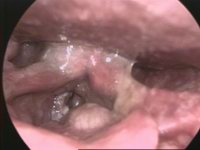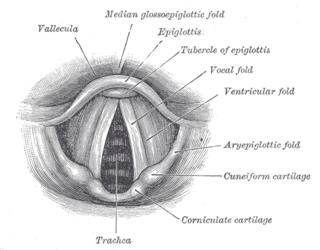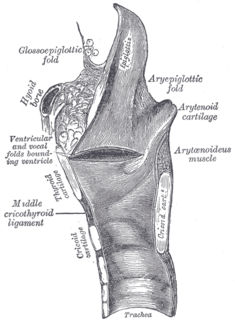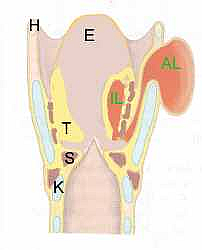The term phonation has slightly different meanings depending on the subfield of phonetics. Among some phoneticians, phonation is the process by which the vocal folds produce certain sounds through quasi-periodic vibration. This is the definition used among those who study laryngeal anatomy and physiology and speech production in general. Phoneticians in other subfields, such as linguistic phonetics, call this process voicing, and use the term phonation to refer to any oscillatory state of any part of the larynx that modifies the airstream, of which voicing is just one example. Voiceless and supra-glottal phonations are included under this definition.

In humans, vocal cords, also known as vocal chords, vocal folds or voice reeds, are folds of tissue in the throat that are key in creating sounds through vocalization. The size of vocal cords affects the pitch of voice. Open when breathing and vibrating for speech or singing, the folds are controlled via the recurrent laryngeal branch of the vagus nerve. They are composed of twin infoldings of mucous membrane stretched horizontally, from back to front, across the larynx. They vibrate, modulating the flow of air being expelled from the lungs during phonation.
In linguistics, voicelessness is the property of sounds being pronounced without the larynx vibrating. Phonologically, it is a type of phonation, which contrasts with other states of the larynx, but some object that the word phonation implies voicing and that voicelessness is the lack of phonation.

The larynx, commonly called the voice box, is an organ in the top of the neck involved in breathing, producing sound and protecting the trachea against food aspiration. The opening of larynx into pharynx is about 4 - 5 centimeters in diameter. The larynx houses the vocal folds, and manipulates pitch and volume, which is essential for phonation. It is situated just below where the tract of the pharynx splits into the trachea and the esophagus. The word larynx comes from a similar Ancient Greek word.

The trachea, also known as the windpipe, is a cartilaginous tube that connects the larynx to the bronchi of the lungs, allowing the passage of air, and so is present in almost all air-breathing animals with lungs. The trachea extends from the larynx and branches into the two primary bronchi. At the top of the trachea the cricoid cartilage attaches it to the larynx. The trachea is formed by a number of horseshoe-shaped rings, joined together vertically by overlying ligaments, and by the trachealis muscle at their ends. The epiglottis closes the opening to the larynx during swallowing.

The epiglottis is a leaf-shaped flap in the throat that prevents food from entering the windpipe and the lungs. It stays open during breathing, allowing air into the larynx. During swallowing, it closes to prevent aspiration of food into the lungs, forcing the swallowed liquids or food to go along the esophagus toward the stomach instead. It is thus the valve that diverts passage to either the trachea or the esophagus.

Laryngeal cancers are mostly squamous-cell carcinomas, reflecting their origin from the epithelium of the larynx.

The Adam's apple or laryngeal prominence, is the lump or protrusion in the human neck formed by the angle of the thyroid cartilage surrounding the larynx seen especially in males.

Laryngitis is inflammation of the larynx. Symptoms often include a hoarse voice and may include fever, cough, pain in the front of the neck, and trouble swallowing. Typically, these last under two weeks.

The posterior cricoarytenoid muscles are small, paired intrinsic muscles of the larynx that extend between cricoid cartilage to the arytenoid cartilages in the larynx.

The cricoid cartilage, or simply cricoid or cricoid ring, is the only complete ring of cartilage around the trachea. It forms the back part of the voice box and functions as an attachment site for muscles, cartilages, and ligaments involved in opening and closing the airway and in producing speech.

The arytenoid cartilages are a pair of small three-sided pyramids which form part of the larynx, to which the vocal folds are attached. These allow and aid in the vocal cords' movement.

The laryngeal inlet is the opening that connects the pharynx and the larynx.

Laryngomalacia is the most common cause of chronic stridor in infancy, in which the soft, immature cartilage of the upper larynx collapses inward during inhalation, causing airway obstruction. It can also be seen in older patients, especially those with neuromuscular conditions resulting in weakness of the muscles of the throat. However, the infantile form is much more common. Laryngomalacia is one of the most common laryngeal congenital disease in infancy and public education about the signs and symptoms of the disease is lacking.

The arytenoid is a single muscle, filling up the posterior concave surfaces of the arytenoid cartilages.

The anterior or lingual surface of the epiglottis is curved forward, and covered on its upper, free part by mucous membrane which is reflected on to the sides and root of the tongue, forming a median and two lateral glossoepiglottic folds; the lateral folds are partly attached to the wall of the pharynx.
Chest voice is a term used within vocal music. The use of this term varies widely within vocal pedagogical circles and there is currently no one consistent opinion among vocal music professionals in regard to this term. Chest voice can be used in relation to the following:

The infraglottic cavity is the portion of the larynx below the laryngeal ventricles and the rima glottidis.

A roar is a type of animal vocalization consisting of both a low fundamental frequency (pitch) and low formant frequency. Many mammals have evolved to produce roars and other roar-like vocalizations for purposes such as long-distance communication and intimidation. These include most big cats and bears, some pinnipeds, hammer-headed bats, various bovids, red deer, elephants, gorillas and howler monkeys.

The pharynx is the part of the throat behind the mouth and nasal cavity, and above the esophagus and trachea – the tubes going down to the stomach and the lungs. It is found in vertebrates and invertebrates, though its structure varies across species. The pharynx carries food and air to the esophagus and larynx. The flap of cartilage called the epiglottis stops food from entering the larynx.


















